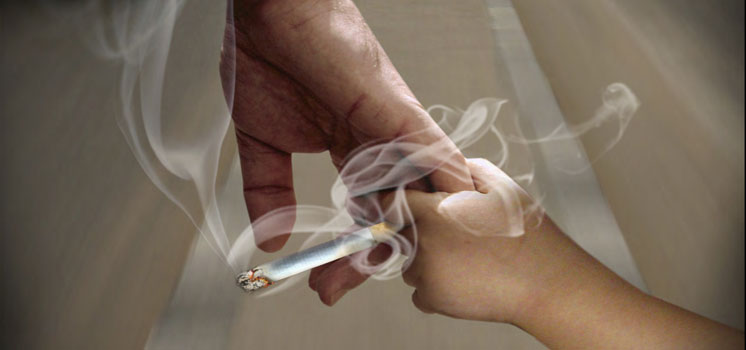The danger of second-hand smoke
Second-hand smoke is a mixture of the smoke from the burning tip of a cigarette and the smoke exhaled by a smoker. When second-hand smoke contaminates the air, especially in enclosed spaces, it is inhaled by everyone, exposing both smokers and non-smokers to its harmful effects. It causes lung cancer in non-smokers and increases the risk of coronary heart disease.
Although the majority of smokers are men, many women and children are affected by their second-hand smoke. Worldwide, second-hand smoke causes an estimated 600 000 premature deaths a year, the majority (64%) among women. In the Eastern Mediterranean Region 38% of students aged 13–15 are exposed to second-hand smoke at home, and in many countries only around a quarter of homes are smoke-free. Only around 50% of schools ban the use of tobacco products by teachers.
The harm to health from second-hand smoke
There are over 4000 known chemicals in tobacco smoke, many of which are harmful, with at least 40 that cause cancer. It also includes large quantities of carbon monoxide, a gas that hinders the blood’s ability to carry oxygen to vital organs such as the heart and brain, and substances that contribute to heart disease and stroke. Exposure to second-hand smoke has both immediate and long term effects, including the following:
Immediate effects include irritation of the eyes, nose, throat and lungs, and sometimes headaches, nausea and dizziness. Exposure can also trigger asthma attacks.
Long-term exposure to second-hand smoke causes lung cancer, coronary heart disease and cardiac death. Non-smokers who live with smokers are at increased risk of smoking-related illnesses. The risk of coronary heart disease is increased by 25%–30% and lung cancer by 20%–30%.
Second-hand smoke risks for children
Exposure to second-hand smoke during pregnancy is associated with decreased birth weight. This can lead to increased risk of developing medical problems and learning difficulties. Parents who smoke may harm their infant children by increasing the risk of sudden infant death syndrome, reduced physical development and childhood cancer.
Children are particularly vulnerable to second-hand smoke due to their smaller lungs and less developed immune systems. Exposure to second-hand smoke in children results in respiratory illnesses, chronic respiratory symptoms (such as asthma), ear infections and reduced lung function. Children of smoking mothers have more episodes of respiratory illness. There is a clear link between smoking in the home and the hospital admission of children for pneumonia and bronchitis.
Protection against second-hand smoke
Non-smokers need to be protected from second-hand smoke exposure within the home, at school and in the workplace. Women and children often do not have the power to negotiate smoke-free spaces, even within their own homes. Some workers are obliged to spend most of their work time in a health-threatening environment.
Protection can be achieved through smoking bans and by smokers taking responsibility for not exposing others to their second-hand smoke. Smoke-free legislation is very popular wherever it is enacted, with support for tobacco control measures usually increasing after implementation. Smoke-free workplaces help to motivate smokers to quit smoking and reduce tobacco consumption by 4%–10%. Smoke-free policies also help prevent people, especially the young, from starting to smoke.
The tobacco industry has tried to argue that smoking bans infringe smokers’ rights and freedom of choice, but no one has the right to harm others. Smoke-free laws do not infringe anyone’s rights and are simply there to protect people’s health by regulating where to smoke and where not to smoke.
Best practices and the way forward
Article 8 of the WHO Framework Convention on Tobacco Control addresses protection from exposure to tobacco smoke. It stipulates that all people need to be protected from second-hand smoke through the adoption and implementation of legislative and other measures to provide protection from exposure to tobacco smoke in indoor workplaces, public places and public transport.
It is important to remember the following:
There is no safe level of exposure to second-hand smoke.
Non-smokers, including women and children, have a right to breathe tobacco-free clean air.
Ventilation or designated smoking-rooms do not offer effective protection.
All indoor workplaces, public transport, schools and health services should be smoke-free.
People need to be better informed of the hazards of second-hand smoke to themselves, foetuses, children and other family members.









